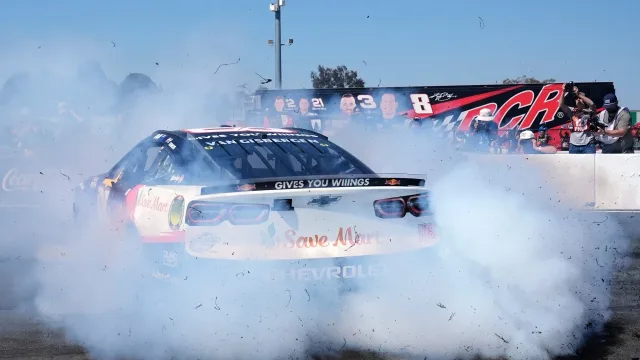Shane van Gisbergen, a high-profile international rookie in NASCAR, has candidly discussed his unexpected difficulties adjusting to oval racing, pinpointing the demanding concrete of Dover Motor Speedway as a significant challenge. During a recent conversation with Dale Earnhardt Jr., van Gisbergen highlighted the complexities of racing ovals compared to his successes on road and street tracks, shining a light on the distinctive learning curve international drivers experience in NASCAR.
Van Gisbergen Shares Candid Thoughts on Adjusting to Concrete Ovals
As a champion known primarily for excelling in Supercars and road courses, van Gisbergen entered NASCAR with plenty of momentum, already clinching three wins on non-oval tracks this season. However, the jump to high-banked concrete ovals such as Dover has been far from straightforward. The unique surface and tire dynamics at tracks like Dover and Bristol have exposed a steep adaptation curve, testing skills not often required in other series worldwide.
Van Gisbergen described how early practice sessions can be especially overwhelming, revealing the difference from typical racing environments. He noted,
“Well, firstly, probably Dover. Practice will start, and Bristol was sort of the same. Practice will start, and it’ll be just on the bottom, and you’ll be running your line as fast as you can, and doing the qualifying line, just going hammer and tong.”
—Shane van Gisbergen, Race Winner
Understanding the Tire Dynamics That Complicate NASCAR Ovals
Getting a handle on tire performance has been a major obstacle for van Gisbergen in his transition from road to oval racing. The unpredictability and sensitivity of the tires, particularly at Dover, introduce variables that drivers from other series may not anticipate. He admitted how getting up to speed often means losing the tire’s optimal performance window.
“But yeah, as you said for me, by the time I get up to speed, the peak of the tires gone,”
said Van Gisbergen.
Once the race advances, the track itself changes rapidly, presenting new challenges.
“Then you’re just trying to learn, but then when you get in the race, all of a sudden the track rubbers up.”
—Shane van Gisbergen, Race Winner
The evolution of the racing line and changing grip levels only add to these difficulties. According to van Gisbergen,
“It’s very graphic to me on concrete, it rubbers up so much and then all of a sudden the line moves and you’re doing a different line to what you’ve done, and this tire it hates itself. Like when the rubber goes down, the rubber’s bad.”
—Shane van Gisbergen, Race Winner
Unique Traits of NASCAR Ovals Revealed Through Experience
Van Gisbergen emphasized how the constantly evolving surface at Dover forces drivers into unfamiliar territory, sometimes resembling dirt track conditions. He observed the necessity of scanning the track for grip, especially as the coloring of the racing surface shifts throughout a run.
“And then you’re watching this track just change color, and you’re trying to find light spots for grip, and then the yellow comes out, and I don’t know what it is or whether the new tires pick up the rubber, the track just changes color, and the cycle starts again. It’s yeah, it’s amazing. There’s no other series I’ve ever been a part of that does it.”
—Shane van Gisbergen, Race Winner
These insights from a driver with experience across multiple racing disciplines highlight why international drivers, even decorated champions, face immense obstacles in NASCAR’s unique world of oval racing. While van Gisbergen’s road course triumphs have drawn attention this season, his honest reflections on Dover’s ever-changing surface and tire behavior underscore the tough transition that comes with competing on NASCAR ovals.
As van Gisbergen continues to learn from each race at tracks like Dover and Bristol, his journey further illustrates the complexities of making the jump to NASCAR from other forms of motorsport. His perspective not only sheds light on the technical demands facing rookies but also on how each track and surface type in NASCAR introduces its own brand of unpredictability, making every oval event a new challenge for even the most talented drivers.
Our Reader’s Queries
Q. What happened to Shane van Gisbergen, Adelaide?
A. Sadly, Van Gisbergen’s last races did not go as planned. On Saturday, during the first lap, he hit Will Brown’s car, which had already crashed at Turn 4. On Sunday, he faced braking problems that prevented him from completing the race.
Q. Is Shane van Gisbergen an American citizen?
A. Shane Robert van Gisbergen, who goes by the initials SVG, was born on May 9, 1989. He is a professional race car driver from New Zealand.
Q. How many Supercar Championships did Shane van Gisbergen win?
A. Often called “SVG,” van Gisbergen has a strong track record in racing. He has won the Bathurst 12-hour race and stood on the podium at the 24 Hours of Daytona. Additionally, he has secured three championships in the Australian Supercars series.
